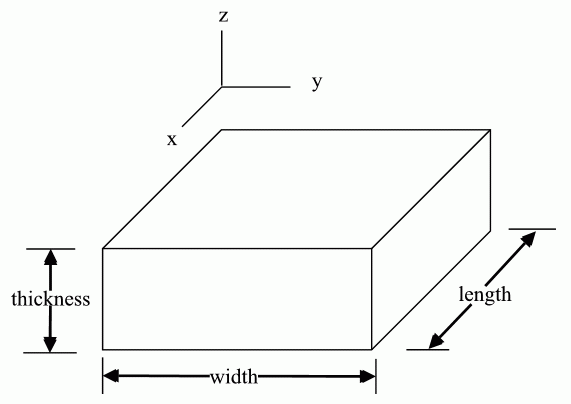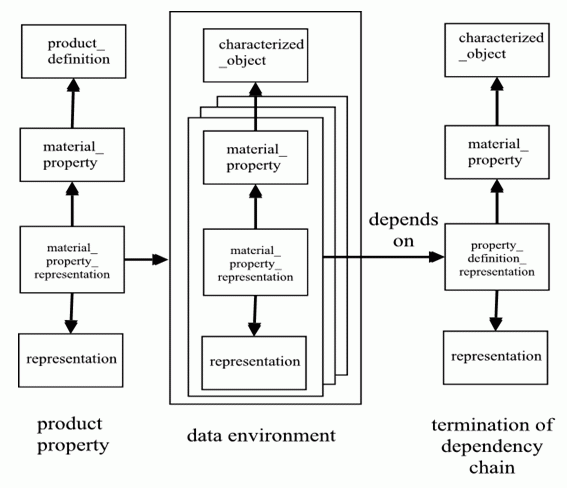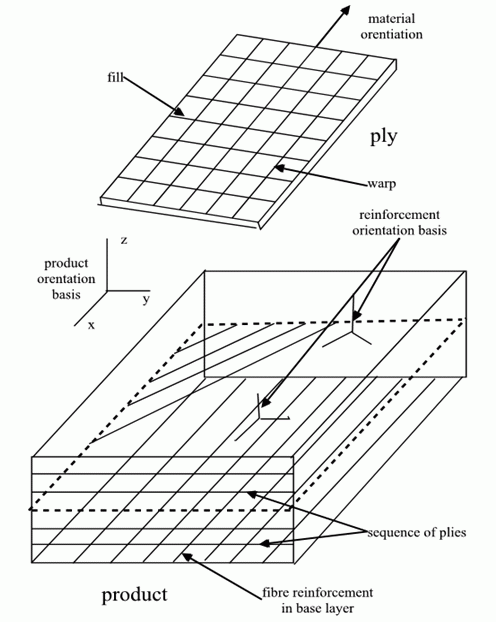
| Integrated generic resource: Material and other engineering properties | ISO 10303-45:2019(E) © ISO |
All manufactured products are made of substances whose properties contribute to the behaviour of the product during its production and in service. This part of ISO 10303 enables those properties which are closely associated with the substance of the product to be described. It follows that what are commonly called: “materials”, “engineering materials”, “raw materials” or “starting materials” are all products, resulting from a production process. Properties of such products can be described by using the resources in this part of ISO 10303.
Since the focus is on the properties of a product, the constructs in this part of ISO 10303 can be used for the products of the materials industry, as well as the products of other manufacturing sectors. In this annex the manner in which this description is achieved is explained and examples of the use of the constructs are given.
The properties of a product which are the subject of this part of ISO 10303 are those which are either determined by a measurement procedure or are assigned by agreement, such as standardized properties or values approved for design. The value of a property of a product has to be associated with the conditions under which it is valid. Some properties of materials may be related to the fundamental nature of the substance. These may be referred to as intrinsic properties. This part of ISO 10303 does not attempt to provide separate resources for this category of properties.
The names of specific properties are not included in this part of ISO 10303. The naming of properties is the responsibility of those application protocols which use the generic resources provided in this part of ISO 10303. For these application protocols it is assumed that the names and definition of testing methods and of the properties that they define will be specified in a data dictionary conforming to ISO 13584 Parts Libraries [6]. There are also several other concepts commonly used in the description of engineering materials which are provided for in other parts of ISO 10303. An example is the, so-called, “class” of a material (e.g., ceramic, polymer: metallic alloy, etc.).
E.2 Example of a productIn this section, a hypothetical product called the “part 45 example product” is described by both diagrams and words. This product provides the basis for explaining how different properties are associated with the product. See Figure E.1 for a diagram of this product.
The product is a regular, rectangular block. An orthogonal coordinate system corresponds to the principal dimensions of the block. This shape has been chosen to highlight the concept that a simple exterior shape can have a complex internal arrangement. The internal arrangement is called the material structure of the product. There are four possible alternative situations. The interior of the product could be:

An example of the first situation would be a sintered compact of either a uniform metallic or ceramic powder. An example of the second category would be a compression moulding of a thermosetting polymer with an inorganic particulate filler. An example of the third would be a sheet rolled from a metal alloy. An example of the fourth would be a plate manufactured as a fibre-reinforced, polymer resin composite.
There are, therefore, several different materials and processes which could be used to manufacture this product. Each of them would result in a characteristic set of material properties for the product. The descriptions of the process of manufacture and the conditions during the manufacture of a product are achieved by using the resources in ISO 10303-49 [5].
A real example of the part 45 example product could be aluminium alloy sheet, manufactured by rolling to the specification of British Standard BS1470:1987 and intended for use as a cladding for buildings. Some of the details of the product would be described by using the entities in ISO 10303-41. The entities: product_context, product_definition_context and product_related_product_category from ISO 10303-41 can contain information about the intended use of the product. The entities: product, product_definition_formation and product_definition from ISO 10303-41 can contain information about the product, such as the trade name, the sheet thickness, the batch number, the condition (e.g., annealed). The linking of a product to a specification document (e.g., BS1470:1987) would be achieved by defining an entity in an application protocol with an attribute which has a reference to the document entity in ISO 10303-41.
E.3 Material designationProducts of the materials industries are usually identified and classified by means of alphanumeric strings, defined by national, regional, or international standards, which are called the material designation. A material designation is usually associated with a particular element composition of the product. An example of a material designation for a sheet of aluminium alloy would be: “3105”. The product standards also allow for a designation to be extended by adding further letters and numbers to indicate other distinguishing characteristics, such as the metallurgical condition. Therefore a sheet of an aluminium alloy which had been hardened by rolling could have the material designation 3105-H12, where “Hl2” indicates the hardened condition. Sheets of the same alloy in the same condition but with different thicknesses, which are therefore different products, could have the same material designation. Therefore, the material designation is a label with important engineering implications and these have been provided for in this part of ISO 10303.
The material_designation entity in this part of ISO 10303 associates a material designation with a product by reference to the product_definition entity in ISO 10303-41. The association of a material designation with either a material_property or a product_material_composition_relationship is achieved by using the material_designation_characterization select type and this can be used to indicate which engineering concepts give rise to the designation.
E.4 Composition of a productISO 10303 provides constructs to enable the composition of a product to be described and to associate the composition with a material designation. The constructs can be used for elements combined as alloys or compounds or for components forming a composite mixture, such as fibre-reinforced plastics or steel-reinforced concrete products.
Each constituent of the composition is described as a product by combining the use of entities from ISO 10303-41 and this part of ISO 10303. The product entity (ISO 10303-41) can contain the name of the constituent, for example silicon as one constituent of the aluminium alloy designation 3105. The product_context entity from ISO 10303-41 can describe the context of the constituent as chemical composition, for example. The product_definition entity from ISO 10303-41 can define a constituent as a chemical element, or as a fibre-reinforcement in a composite.
Each instance of product_material_composition_relationship describes the relationship of a component of the composition to the whole. The constituent_amount attribute is a set that can contain one or more values of the amount of a constituent, such as the maximum and minimum values.
Values of composition in standard specifications are not usually described by single value numbers. For example, a composition value can be specified as 'less-than' a given value. Several elements can be combined to specify that the sum of their values is less than a limiting value. Usually the composition of the principal element in an alloy is not given but is specified as 'balance', i.e. the difference between 100 percent and the sum of all the other actual values.
This new edition now enables a composition value to be specified as a mathematical function using the resources of ISO 10303-50. The select type characterized_product_composition_value enables the attribute constituent_amount to be either a measure_with_unit or a maths_value_with_unit. The unit for the composition value could be a context_dependent_unit such as “weight fraction in percent”, for example.
Each value of the composition can be qualified. That is, it can be identified as a maximum or minimum value, for example, and it can also be associated with the uncertainty on the value (see clause E.8). This capability is available for both the value as a number and for the value as a mathematical function.
E.5 Properties and measurement conditionsIn this part of ISO 10303, values of material properties are always associated with the conditions in which they are valid. These conditions are called the data environment. The components of the data environment for a measured value are the operational parameters at the time of the measurement which have an influence on the numerical value of the result such as: temperature, loading rate, gauge length, etc. Dependencies between measurement conditions can also be described and linked together in a chain of dependencies. For example, the correction factor for misalignment in a uniaxial tensile test is derived from the values of three extensions measured at symmetrical locations on the surface of the test piece. The model allows for the description of the three extensions and the corrected value which depends on them.
The representation of the numerical value of the property is achieved by using the resources provided in ISO 10303-43. The decision to use representation was made in preference to the apparently simpler method used for composition because it enables a property to be associated with a system of coordinates and provides resources for transformations between coordinate systems. This decision therefore enables the properties to be related to a direction in the product.
The components of the data environment are described in the same manner as the property values, using the same resources from ISO 10303-43, and therefore they can also have their directions described with respect to a frame of reference related to the principal directions of the product.
Examples of directional properties as a result of directional conditions would be the Hall effect in semiconductors or the acoustic emission of a single crystal transducer. In these circumstances the direction of the application of the stimulus and the direction of the response must be known with respect to the geometry of the product and also with respect to its crystal structure in these particular examples. A blade in the first hot stage of a gas turbine engine can be manufactured as a single crystal with its crystallographic orientation related to the geometry of the blade. This preferred orientation provides for a favourable anisotropy of the behaviour under the load conditions during operation.
The relationship of any test piece sample to the anisotropy of a product should also be described.
The product can have any number of properties and each representation of one property could have several data environment conditions. Figure E.2 shows, in a simplified manner, an illustration of the relationships between a material property, the product definition, the representation of a property and its associated data environments. The first sequence associates a property with the product. This property is associated with one or many environment conditions. The value of each condition is described in a similar manner to a property. The last sequence in the diagram illustrates the proper termination of a chain of dependencies in the data environment.

The manufacturing process can alter the substance in different regions of the product to produce differences in properties between these regions. An example would be a sheet of aluminium alloy formed into a product by pressing between two matched dies. Some regions of the sheet will be stretched by greater amounts than others and the properties of those regions will be different as a consequence of the greater, local plastic deformations. Alternatively, some regions of the product may have had additional processing by, for example, selectively hardening one region of the surface. In ISO 10303 an identifiable, geometrically defined portion of the shape of a product is referred to as a shape aspect.
This part of ISO 10303 therefore provides the resources to associate material properties with a shape aspect. This is achieved by the material_property entity which specializes the property_definition entity (in ISO 10303-41) to allow it to be associated either with a whole product or with a shape of a product. The geometry of the shape aspect of the product is described by using the resources in ISO 10303-42 [3].
E.7 Product structureIn many engineering applications it is necessary to describe the internal structure of the product - the material structure. The influence of the material structure of the product on the properties is particularly important when the product is made as a mixture of solids, such as polymer resins reinforced with arrangements of glass fibres, for example.
As an example of a complex structure, a composite product can be regarded as being built up from a collection of shapes. In composite technology, these shapes have different terms to describe the role that they play in the intermediate stages and in building up the final composite product. The names and definitions of these terms would be specified in an application protocol.
The constituent of the material structure of the product and their proportions can be described by following the same method used for specifying the composition. In both cases the components are treated as individual products and related to the whole product. The additional concept which enables the constituents of the structure to be described is that they can have the property of shape. The structural constituents may also be oriented with respect to the product frame of reference as shown in figure E.3 which indicates the arrangements of fibres in the bottom layer and an intermediate layer of a multi-layer composite product built up from a series of plies in a layer stacking sequence.
This version of the part 45 example product is therefore manufactured from a series of intermediate products. The structure of each layer will have its own coordinate basis and these bases will be related to the product basis by an appropriate transformation. Each intermediate product will have its own composition and properties described by the resources in this part of ISO 10303.
ISO 10303-42 and ISO 10303-43 provide the resources used to describe the shapes of the components of the structure, their alignments with respect to each other, and to the product as a whole. The concept of the internal structure is different from the concept of a mechanical assembly, described in ISO 10303-44 [6] in that the organisation of a material structure will include interactions and intersections between the different shape representations making up the structure. Therefore it would be expected that the concepts from ISO 10303-42 and ISO 10303-43 would be used differently to represent material structure in an implementation than they would be for a mechanical assembly.
E.8 Qualification of property valuesNumerical values for properties represent the best estimate of the value which could be obtained in the conditions which applied. Successive measurements of the same property do not, in general, produce identical results and therefore all measured values are subject to an uncertainty. In addition, values of numerical properties, whether or not they are measured values, are often qualified to indicate that they represent either a minimum or a maximum value, for example.
This part of ISO 10303 provides the resources to associate qualifiers and statistically defined measures of uncertainty with both quantitative or qualitative values of properties and their associated measurement conditions.

Measures of uncertainty and qualifiers of values can be associated with both composition values and property values.
Examples of the uses of these resources include:
Specifications of products commonly use several other items of information and data related to the material substance in addition to those which are included within the scope of this part of ISO 10303. These additional items are modelled by resources located elsewhere in ISO 10303. These resources are available to implementations of this part of ISO 10303 because of the integration of this part with the other parts of ISO 10303.
Examples include:
© ISO 2019 — All rights reserved